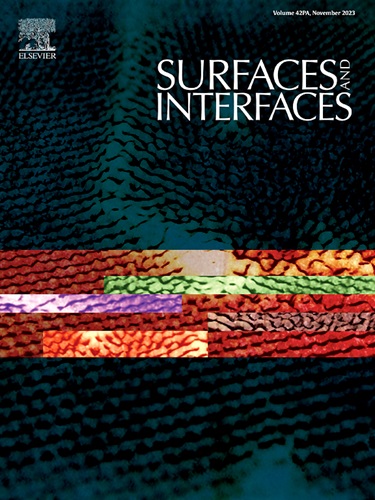电场诱导的响应表面结构和蛋白质行为调制的分子机制
IF 5.7
2区 材料科学
Q2 CHEMISTRY, PHYSICAL
引用次数: 0
摘要
蛋白质在电响应表面上的行为对各种生物技术应用至关重要。采用分子模拟研究了外电场(EFs)对具有不同表面电荷密度(SCDs)的长羧基/羧酸末端链和短羟基末端链的混合SAMs的结构和润湿性的影响,以及它们对蛋白质行为的影响。分析表明,如果没有外部电场,SCD的增加会导致羧基/羧酸末端链的紊乱程度更高。在正EF下,随着SCD的升高,更多的羧酸端链排列成直线,暴露出SAMs最外层的带电基团,从而增加了表面亲水性。在负EF下,随着SCD的增加,更多的羧酸末端链弯曲,暴露出烷基部分并将带电基团埋在sam内,从而增强了表面疏水性。当SAM完全去质子化时,会产生疏水和亲水交替的区域。正、负电场均削弱了蛋白质与表面的相互作用。前者归因于形成更紧密结合的水层和反离子的屏蔽作用;而后者是由于静电相互作用减少和来自反离子的竞争。溶菌酶主要通过其右侧吸附到sam上。然而,在高SCD和正EF的条件下,溶菌酶通过其底部吸附,其活性位点易于接近。在电场作用下,溶菌酶的构象随SCD的变化而发生不规则变化,这取决于蛋白质与表面的耦合相互作用。这些发现为生物技术应用的电响应表面设计提供了有价值的见解。本文章由计算机程序翻译,如有差异,请以英文原文为准。
Molecular mechanisms of electric field-induced modulation of responsive surface structures and protein behavior
Protein behavior on electro-responsive surfaces is critical for various biotechnological applications. Molecular simulations were used to investigate the effects of external electric fields (EFs) on the structure and wettability of mixed SAMs comprising long carboxyl/carboxylate-terminated chains and short hydroxyl‑terminated chains with varying surface charge densities (SCDs), as well as their resulting influence on protein behaviors. Analysis reveals that without external EFs, increased SCD leads to higher degrees of disorder in carboxyl/carboxylate-terminated chains. Under a positive EF, as the SCD rises, more carboxylate-terminated chains align straight, exposing charged groups on the outermost layer of the SAMs, thereby increasing the surface hydrophilicity. Under a negative EF, as SCD increases, more carboxylate-terminated chains bend, exposing the alkyl parts and burying the charged groups within the SAMs, thereby enhancing surface hydrophobicity. When fully deprotonated, the SAM generates alternating hydrophobic and hydrophilic regions. Both positive and negative EFs weakened the protein-surface interactions. The former is attributed to the formation of the more tightly bound water layer and the shielding effect of counterions; whereas the latter is due to the reduced electrostatic interactions and competition from counterions. Lysozyme primarily adsorbs onto the SAMs through its right side. However, under conditions of high SCD and a positive EF, lysozyme adsorbs via its bottom site, where its active site is easily accessible. Lysozyme conformation changes irregularly with SCD under an electric field on SAMs, depending on the coupling interactions between protein and surface. These findings provide valuable insights into the design of electro-responsive surfaces for biotechnological applications.
求助全文
通过发布文献求助,成功后即可免费获取论文全文。
去求助
来源期刊

Surfaces and Interfaces
Chemistry-General Chemistry
CiteScore
8.50
自引率
6.50%
发文量
753
审稿时长
35 days
期刊介绍:
The aim of the journal is to provide a respectful outlet for ''sound science'' papers in all research areas on surfaces and interfaces. We define sound science papers as papers that describe new and well-executed research, but that do not necessarily provide brand new insights or are merely a description of research results.
Surfaces and Interfaces publishes research papers in all fields of surface science which may not always find the right home on first submission to our Elsevier sister journals (Applied Surface, Surface and Coatings Technology, Thin Solid Films)
 求助内容:
求助内容: 应助结果提醒方式:
应助结果提醒方式:


